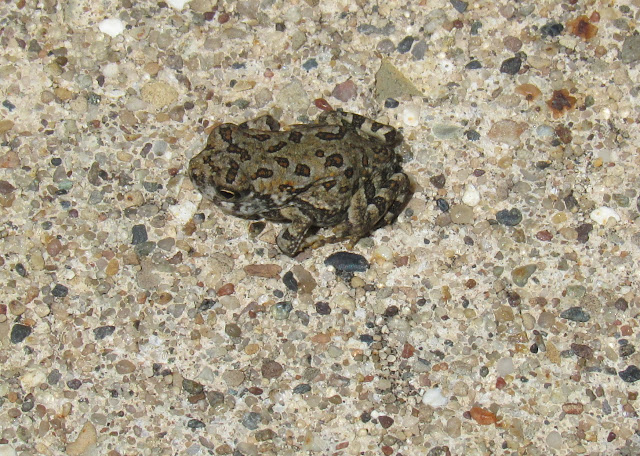I'll be honest, I had my expectations a bit high...
...when going to someplace as innocently named as the Devil's Neck, I did not expect to see butterflies feasting on a skeleton in the parking lot. This was mildly disturbing.
Most were gray, but there were a few with more colors, as shown below. I believe the one below is a Hackberry Emperor (Asterocampa celtis).
On a nearby power line, this Lark Sparrow (Chondestes grammacus) decided to stop and say hi.
Well, after going a bit of a way into the woods near the parking lot. we came to the conclusion that, thanks to the poison ivy, the route was impassable. Of course, I had forgotten to wear long socks and/or jeans, both of which might have helped to mitigate the damage. We drove north, to another trail where I felt we might be able to get by easier. This was in fact the case. After about half a mile, we reached the far edge of the woods... and more poison ivy. We'd found a couple of ticks so far, and were rather frustrated by the sheer impassibility. I was determined, however, to get back to where I had been before. We finally made it to the dry sand dunes, north of the previous locale.
Eastern Prickly Pear (Opuntia humifusa), Illinois' main species of cactus, had its flowers open, easily one of the most beautiful flowers I've seen all year. It was the first time I'd ever seen Eastern Prickly Pear in bloom in the wild. In this post's first photo, look for somebody in disguise inside the flower.
We reached the top of a nearby sand dune, known as the Devil's Neck. It certainly had been a devil of a time getting there, but we made it, and the views over the Illinois River Valley almost made up for the trip. Almost. but not quite. Still, there was more to come...
In a large blowout (an area where the wind has made a large depression in the sand in front of a dune) in front of the Devil's Neck, a botanist by the name of Henry Allan Gleason had discovered one of the rarest plants in Illinois. Behold, the Silvery Bladderpod (Lesquerella ludoviciana)!
Silvery Bladderpod (named for its inflated seedpods) is fairly common out in the northern Great Plains, but here in Illinois it's only found in one place. The Silvery Bladderpod habitat certainly looks more like it should have a few tumbleweeds blowing across than being a half hour south of Peoria, Illinois. Even among the sand prairies in Mason County, this spot is especially desolate.
It's not often in Illinois that you can take a picture of the entirety of a species' habitat in one picture. Here, I can, and I did. If I had an inch more to the left, I would have photographed the entire habitat of this plant species in Illinois. To me, that's very, very exciting.
However, Silvery Bladderpods are not particularly exciting plants, and my attention was soon drawn to a nearby Prairie Sunflower (Helianthus petiolaris), a species new to me, as so many are in this part of Central Illinois. The sandy soils of Mason County, as I have said before, are beneficial for three reasons. #1. They make it harder to farm, leaving more of the country in a natural state. #2. They attract a wide variety of plants and animals which prefer sandy soils.
On the return trip, we spotted this dragonfly, the female Twelve-spotted Skimmer (Libellula pulchella), a common American dragonfly, albeit one of the larger ones.
After yet another trek back through the tick and poison ivy infested woods, we made our way back to the car. I removed seven ticks from myself after this hike, one dog tick and six deer ticks. Without bug spray, I'd hate to imagine how many ticks I would've picked up. We drove on to a nearby fish hatchery, where at least eight juvenile toads were hopping about on the pavement:
Sincerely, these guys were tiny. As in about the size of my thumbnail.
The fish hatchery was mostly inactive, not unlike most state-run projects currently.
We drove on afterwards, to a nearby wetland, where I made many Star Trek references...
To Be Continued!

















No comments:
Post a Comment